Can English Bulldogs Live Outside?
March 6, 2022 2022-03-06 18:26English Bulldogs are fun dogs that make silly, lovable, affectionate family pets. They’ve come a long way from their start as bull-baiting dogs, from which they got their name. Despite their grisly history, English Bulldogs are still strong and brave. Their temperaments have been managed through careful breeding to make them mellow dogs that get along well with people, including children.
Since they were originally bred for a blood sport, you may be wondering what kind of home these dogs would enjoy. Can English Bulldogs live outside? The short answer to this question is absolutely not. But why? Some breeds are well-suited for the outdoors. Why can’t English Bulldogs tolerate the outdoors when they appear to be so robust and hardy?
Let’s take a look at English Bulldogs today and why this breed is meant to be an inside-only dog.
Table of Contents
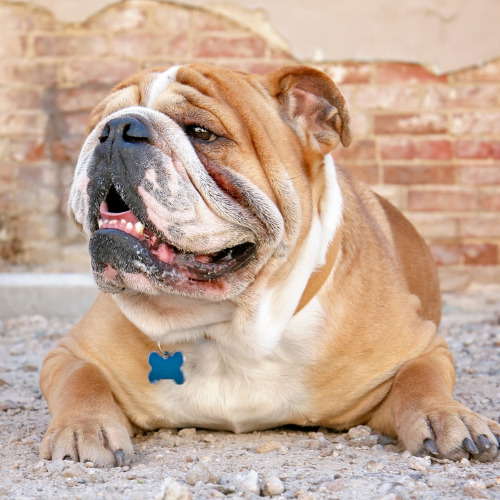
Do English Bulldogs Like the Outdoors?
Just like many other breeds, English Bulldogs do like getting out to enjoy some fresh air, take a stroll, and stretch their legs. They like to feel sunshine on their backs and some of them may even enjoy splashing around in rain puddles.
However, as an owner of an English Bulldog, one must be very aware of the temperature outdoors at all times. This breed cannot tolerate hot or cold weather, and you’ll find yourself having to accommodate their needs based on the daily forecast.
English Bulldogs require a certain amount of exercise to stay healthy and traveling outdoors to accomplish this is perfectly fine. Bulldogs should receive a minimum of 15 minutes of walking each day, but you’ll need to use your discretion in extreme weather. When it’s too hot or too cold, playing games in the house instead is a fun way to keep your dog active and entertained.
What is the Ideal Temperature for English Bulldogs?
Ideal temperatures for English Bulldogs vary. Some dogs can tolerate 75°F while others have difficulty breathing at that temperature. It depends on the individual dog, their health status, age, weight, and physical abilities.
It’s safe to say that any temperature over 80°F and below 50°F is uncomfortable for your English Bulldog. A good rule of thumb is that any temperature that makes you sweat or need a jacket will be too hot or cold for your dog.
Keep an eye on them for signs that they can’t tolerate the heat or cold and use your best judgment when it’s time to take them outside. Read on for more information on what to look for when monitoring your dog outdoors.
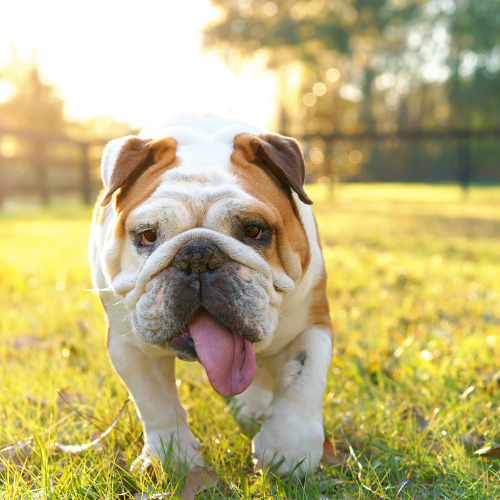
Is it too hot for your English Bulldog to live outside?
English Bulldogs and heat do not mix. This breed is quick to overheat and can have serious health issues if they get too hot.
The short snouts of the English Bulldogs make it difficult for them to pant properly. This makes it hard for these dogs to regulate their body temperatures. What may feel like a pleasant, warm day to you might be overwhelmingly hot for your dog, who is struggling to breathe and keep cool.
Another reason English Bulldogs shouldn’t be in the heat too long is that their extra layers of skin, which also lead to their inability to regulate their body temperatures, can start to smell and breed bacteria. This leads to infections.
Humidity is even more dangerous for English Bulldogs. They can also get sunburned easily if they are in direct sunlight. If your dog suffers from allergies, being outdoors can be extra uncomfortable for them. This is especially true in the springtime when pollen is its worst.
What to Do
Does this mean your English Bulldog can never go outside when it’s hot? Of course not. As long as you are responsible and aware of your dog’s needs, they can join you outside. Here are some things to keep in mind.
- Limit the time you spend outside when it’s warm. English Bulldogs should not be outside longer than 10–15 minutes in hot weather. If it’s extremely hot, the outdoor time should be limited to potty breaks with no energetic exercise taking place.
- Don’t leave your English Bulldog unattended. You’ll need to watch them closely in case you observe signs of overheating.
- Keep your home cool. Your English Bulldog requires air conditioning in hot weather to keep them healthy and comfortable. If your dog can’t breathe outside in hot weather, they won’t be able to breathe inside if your home isn’t cool, either. Cooling pads and beds are a good idea to give your dog a colder place to relax. They may also prefer to flop down on the cold tile floor as an instant cool off when they come inside.
- Set up a pool for your English Bulldog to cool down in when they’re outdoors. However, only keep a few inches of water in it because English Bulldogs are not good swimmers. A shallow pool can keep them cool by letting them splash and wade if they need to be outdoors longer than a few minutes.
- Keep plenty of fresh, cool, clean water nearby for your dog to drink.
- If you notice your dog is in distress, get them inside immediately or hose them down with water to cool them off. Then take them inside.
An English Bulldog is not a breed for summer outdoor activities. They can’t camp, go hiking, head to the dog park, or play fetch in hot weather. Sitting outside at a dog-friendly cafe is also not something that your dog will enjoy when it’s warm outside. If you want a dog to join you in your outdoor activities, there are other breeds that are much better suited for them.
English Bulldogs and Heat Stroke
Heat stroke occurs in English Bulldogs when their bodies cannot regulate themselves in excessive heat. A dog’s body temperature over 105°F is considered dangerous and indicates heat stroke.
Heat stroke can happen to any dog, but it’s more likely to occur in short-nosed, or brachycephalic breeds, like English Bulldogs. If you notice any of these symptoms in your dog during hot weather, heat stroke is possible:
- Excessive, rapid panting
- Drooling
- The dog’s body is hot to the touch
- Rapid heart rate
- Dry nose
- Vomiting
- Dark red mucous membranes in the mouth
- Blood in the mouth or stool
- Seizures
- Staggering; incoordination
- Confusion
- Weakness
- Poorly responsive
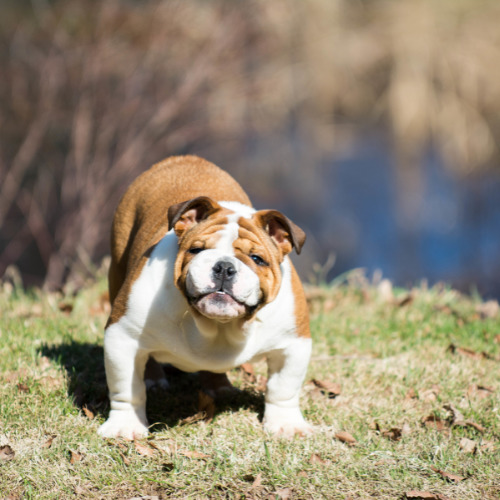
If you notice one or more of these signs, stop what you’re doing and immediately try to cool your dog down. Use a sponge or towel to apply cool water to your dog’s whole body, including their bellies and paws. Make sure the water isn’t cold, as this can cause a rapid decrease in body temperature that would lead to other complications. If you can’t successfully cool down your dog, take them to the vet immediately.

Is it too cold for your English Bulldog to live outside?
Remember those extra folds of skin on the English Bulldog that make it hard for them to regulate their body temperatures? They don’t do much to keep the dog warm, either. They’re thin and loose without any insulating capabilities.
Since the English Bulldog’s nose is so short, they don’t have time to warm up the air they breathe when it’s cold outside. The air immediately goes into their lungs, which effectively lowers their body temperatures. It makes their already-cold bodies even colder, which can quickly lead to hypothermia.
What to Do
If it’s freezing outside, below 32°F, limit your dog’s outdoor time to potty breaks only. Do NOT leave your English Bulldog outside by himself!
If your dog doesn’t go potty at that time, bring them back inside and try again a little while later. These dogs cannot tolerate cold weather for longer than a few minutes at a time. A sweater or coat is a good idea, as well. If your dog will allow you to put boots on them, this can also help ward off hypothermia and frostbite.
When your dog is done outside, bring them in to warm up. Wrap them in a blanket or keep their sweater on them until they feel warm again.
English Bulldogs and Hypothermia
Hypothermia in dogs is identified when the body temperature drops below 99°F. There are three categories of hypothermia: mild, moderate, and severe. A dog is considered to be in a severely hypothermic state when their body temperature drops below 82°F.
When an English Bulldog is experiencing hypothermia, their blood vessels narrow and send blood away from the skin and extremities. It forces the blood to go towards the brain and essential organs to try to keep the dog alive. If you notice any of these signs in your dog when they are outside in cold weather, hypothermia is possible:
- Excessive shivering
- Stiff muscles
- Lethargy
- The body is cold to the touch
- Trouble walking
- Confusion
- Pale gums
Severe hypothermia occurs when the above symptoms stop and are replaced with:
- No shivering
- Slow breathing
- Collapse
- Rapid body temperature drop
- Unresponsiveness
- Unconsciousness
- Dilated or fixed pupils
If you notice the signs of hypothermia beginning in your English Bulldog, they are too cold and must go inside immediately. If the symptoms don’t stop or change into the ones associated with severe hypothermia, this is a life-threatening emergency and your dog needs a vet immediately.
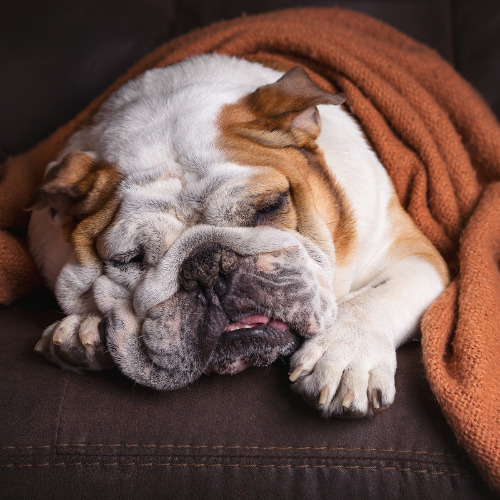
How to Warm a Cold Dog
Once you get your English Bulldog inside, it’s important to warm them up slowly. Wrap them in warm blankets, towels, or your own clothes. Whatever you have available will need to be used. These items can be warmed in a clothes dryer or next to a heater first.
Place a warm water bottle or heating pad next to your dog, but make sure it’s not directly on the dog’s skin. Place some clothing or other fabric between it and your dog. Once the symptoms have stopped, call or bring your dog to the vet to make sure they are okay.
In cases of severe hypothermia, do not try to warm the dog yourself. Just go immediately to the vet’s office.
Your dog will be warmed slowly there with warm IV fluids, and they may be given warm oxygen to breathe. Body temperature, heart rate, blood pressure, and blood sugar levels will all be monitored to make sure the dog is improving.
English Bulldogs and Frostbite
As the blood vessels narrow to direct the English Bulldog’s blood in cold weather, this also puts them at an increased risk of frostbite. The most vulnerable areas of the dog’s body are the paws, ears, tail, and face. Here are some symptoms of frostbite to keep an eye out for whenever your dog is exposed to cold weather for any length of time:
- Discoloration of the skin – often, skin look bluish, gray, or very pale
- Blisters or ulcers
- Swelling
- Pain when touched
- Black or dead skin
If you suspect that your English Bulldog has frostbite, get the vet as soon as possible. You can try to administer some first aid at home if you’re comfortable doing so, but these are just interim suggestions before you see a vet.
Wrap your dog in warm blankets. Use warm, not hot water, to soak towels or cloths to make warm compresses and apply them to the affected areas. Don’t use direct heat, like a heating pad. The areas need to warm up slowly. They also need to stay warm. Unless you’re indoors, don’t attempt to warm up your dog if they are just going to get cold again. This can injure their body tissue beyond repair.
English Bulldogs and Solitude
You now know some physical reasons why English Bulldogs can’t live outdoors, but there is another reason, as well. This reason is just as important.
In order to give your dog the best life you can, you have to meet not only their physical needs but also their emotional ones. English Bulldogs are bred to be companion dogs. They aren’t hunters or guard dogs. They enjoy spending time indoors with their families.
These friendly, sociable, affectionate dogs don’t want to be alone. Living outdoors as a companion breed would harm them emotionally and mentally. They’d get bored and extremely lonely. As such, their personalities could change drastically.
They could become mean, shy, fearful, or depressed. These dogs weren’t designed for life outdoors, alone. Even with other dogs as company, the English Bulldog requires indoor living to be healthy, happy, and safe.
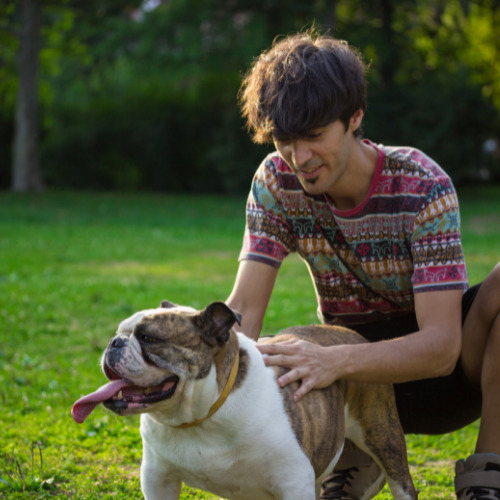
The bottom line
It’s important to keep English Bulldogs indoors at a controlled temperature during extremely hot or cold weather. They can’t regulate their body temperatures and have difficulty breathing in the heat. In cold weather, they can experience hypothermia and frostbite in a short time.
If you notice that your dog is struggling in extreme weather, stop all activity and get your dog inside. If symptoms persist, take them to the vet right away, as this could be a life-threatening emergency.
Above all else, know that English Bulldogs are meant to be your friend and companion. These are dogs that love their spots on the couch next to their owners and playing with their families. They should never live outdoors, and should only spend limited time outside in hot or cold weather.

Author: Jessica Rossetti
Jessica lives in Chicago with her husband, Dominic, and their rescued cat, Toast. She has lived with dogs for over 30 years and spends her days writing, caring for various animals, and enjoying her backyard that has become an oasis for wild creatures.
Her passion for animals began at a young age when she would bring home the lost dog or cat. As she got older, she went on to bring home an injured bird or raccoon. This love and desire to help all creatures led to her work as an adult with various animal rescues, where she saved the lives of many domestic and wild animals while learning the necessary skills to care for them.
Owning and operating a professional pet care service in Chicago for the past twelve years, Jessica cares for dogs in her home while writing full-time.

